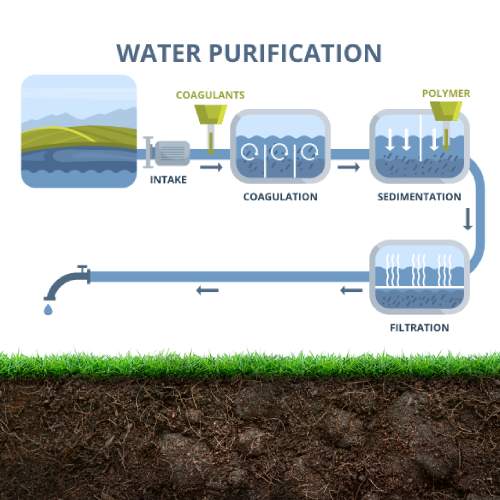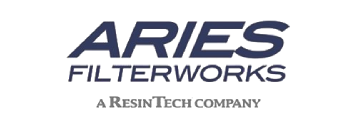
Premium Chemicals for Maximum and Efficient Results
Specially formulated to provide maximum and efficient results, ensuring optimal separation of solids and liquids in the dewatering process. We offer:
Coagulants
Metal Salts: Aluminum sulfate (alum), Ferric chloride, Polyaluminum chloride (PAC), Ferrous sulfate, Calcium oxide (quicklime), Magnesium chloride, Polyamines and Cationic polymers
Flocculants
Polymers: Polyacrylamides (PAM), Polyethylene oxides (PEO), Polyamidoamine epichlorohydrin (PAE), Polyamines, Polydadmacs (PDMDAAC), Chitosan, Guar gum, Starch, Alginates and Cellulose derivatives
Other chemical products
Activated carbon to primarily adsorb hydrocarbons, chlorine dioxide to help break down organic matter, eliminate odors, and disinfect water, CO2, HCL, NaOH, metal chelating agents, and adsorbents such as TR 4210, ion exchange resin
What are Flocculant and Coagulants?
Flocculants and coagulants are types of chemicals used in the dewatering process to help separate solids from liquids.
- Coagulants are made of metal salts and consist of positively charged ions, such as aluminum or iron, that neutralize the negative charges on suspended particles in water. This causes the particles to stick together and form larger aggregates, which are easier to separate from the liquid.
- Flocculants are usually high molecular weight polymers that work by forming bridges between particles to create larger flocs. These flocs settle faster and more efficiently, making it easier to separate the solids from the liquid.
Both types can be used together in a process known as coagulation-flocculation, which is a common method of wastewater treatment.
The Water Purification Process
Coagulation and Flocculation are two types of processes used in water purification
- Coagulation: Is used to destabilize the particles in a liquid, causing them to clump together and form larger particles via a rapid mixing process. Coagulants are typically used in the early stages of the dewatering process to bring the non-settling particles together into larger, heavier masses of solids called floc. Aluminum sulfate (alum) is the most common coagulant used for water purification. Other chemicals, such as ferric sulfate or sodium aluminate, may also be used.
- Flocculation: Is the second step of the water purification process used to further enhance the separation of solids from liquids via a longer period of gentle agitation to promote particle collisions and further enhance the growth of floc. These flocs are then easier to remove from the liquid by the sedimentation and filtration process.
- Filtration: Coagulation and flocculation alone cannot produce crystal-clear water due to non-settling floc and visible turbidity. Filtration, a vital physical process, involves passing water through a porous medium like sand, trapping suspended particles, harmful protozoa, and natural color. While most surface water supplies require filtration after coagulation and sedimentation, sources with low turbidity and color may opt for direct filtration without sedimentation. This process ensures the removal of impurities, improves disinfection, and enhances water clarity.
Types of Chemicals
There are different types of coagulants and flocculants that can be used in dewatering processes, these include:
- Inorganic coagulants: These are typically metal salts such as aluminum sulfate (alum), ferric chloride, and ferrous sulfate.
- Organic coagulants: These are polymers such as polyamine, and polyDADMAC
- Cationic flocculants: These are positively charged polymers that can be used to neutralize the negative charge of suspended solids and promote their agglomeration.
- Anionic flocculants: These are negatively charged polymers that can be used to neutralize the positive charge of suspended solids and promote their agglomeration.
- Non-ionic flocculants: These are neutral polymers that can be used to agglomerate suspended solids through bridging and entrapment.
The selection of the appropriate coagulant or flocculant type depends on the nature of the suspended solids and the water chemistry of the dewatering process.
Environmental Impact
Coagulants and flocculants themselves are not necessarily bad for the environment. However, improper handling and disposal can potentially harm the environment. It is important to follow proper procedures for handling, storage, and disposal to minimize any potential negative impact on the environment. Additionally, some specific types of coagulants and flocculants may have different environmental impacts, so it is important to carefully consider the specific product being used and its potential impact on the environment.
Proper Disposal
To ensure proper environmental disposal of coagulants and flocculants, Nexgen Environmental follows federal and provincial regulations and guidelines for handling and disposing of chemicals. This involves treating the wastewater before discharge, storing the chemicals in proper containers, and arranging for safe disposal through a licensed waste management company. Additionally, depending on the project, we can use eco-friendly alternatives to traditional coagulants and flocculants to minimize their impact on the environment.
Have more questions about our chemical products?
We are the only authorized distributor for ResinTech and Aries FilterWorks in British Columbia
With a commitment to excellence and innovation, Nexgen Environmental provides unparalleled access to high-quality resin and filtration solutions tailored to meet the diverse needs of industries across the region. Whether it’s ensuring pristine water quality, optimizing industrial processes, or enhancing environmental sustainability, our partnership with ResinTech and Aries FilterWorks empowers businesses and communities alike to thrive.
Experience the difference between our comprehensive product range and dedicated service as we strive to deliver excellence in every drop, serving British Columbia with distinction and pride.


